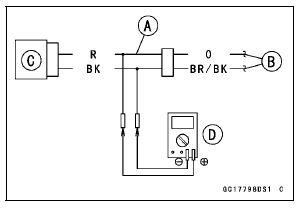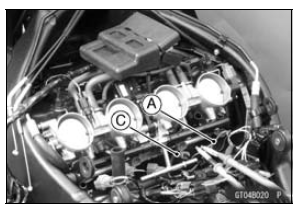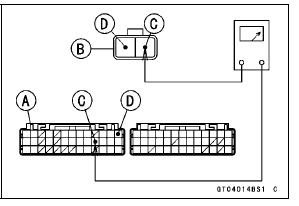

NOTE
Be sure the battery is fully charged.
Harness [B] Water Temperature Sensor [C]
Special Tool - Measuring Adapter: 57001-1700

Water Temperature Sensor Output Voltage Connections to Adapter: Digital Meter (+) → R (sensor O) lead Digital Meter (–) → BK (sensor BR/BK) lead
ECU Intake Temperature Sensor Throttle Body Assy Connectors

Output Voltage
Standard: About DC 2.80 2.97 V at
2.97 V at
20°C (68°F)
NOTE
The output voltage changes according to the coolant temperature in the engine.
If the reading is within the standard, check the ECU for its ground, and power supply (see ECU Power Supply Inspection in the Fuel System (DFI) chapter).
If the ground and power supply are good, replace the ECU (see ECU Removal/Installation in the Fuel System (DFI) chapter).
If the reading is out of the standard, remove the ECU and check the wiring for continuity between harness connectors.
Special Tool - Hand Tester: 57001-1394
Disconnect the ECU and sensor connectors.

Wiring Continuity Inspection ECU Connector [A] ←→ Water Temperature Sensor Connector [B] O lead (ECU terminal 23) [C] BR/BK lead (ECU terminal 13) [D]
If the wiring is good, check the water temperature sensor resistance (see Water Temperature Sensor Resistance Inspection).
 Water Temperature Sensor Removal/Installation
Water Temperature Sensor Removal/Installation Water Temperature Sensor Resistance Inspection
Water Temperature Sensor Resistance InspectionCoupling Bearing Removal
Remove:
Coupling
Grease Seal
Circlip [A]
Special Tool - Inside Circlip Pliers: 57001-143
Remove the bearing [A] by tapping from the wheel side.
Special Tool - Bearing Driver Set [B]: 57001-1129
...
Check 3-5: Warning Indicator Light (Red LED) (Oil Pressure Warning)
Inspection
Connect the leads in the same circuit as Check 3-2.
Connect the terminal [10] to the battery (–) terminal.
Check that the oil pressure warning symbol [A] and the
warning indicator light (Red LED) [B] go on.
If the indicator light does not go on, replace the meter unit.
...
Oil Level Inspection
If the oil has just been changed, start
the engine and run it for severalminutes
at idle speed. This fills the oil
filter with oil. Stop the engine, then
wait several minutes until the oil settles.
NOTICE
Racing the engine before the oil
reaches every part can cause engine
seizure.
...